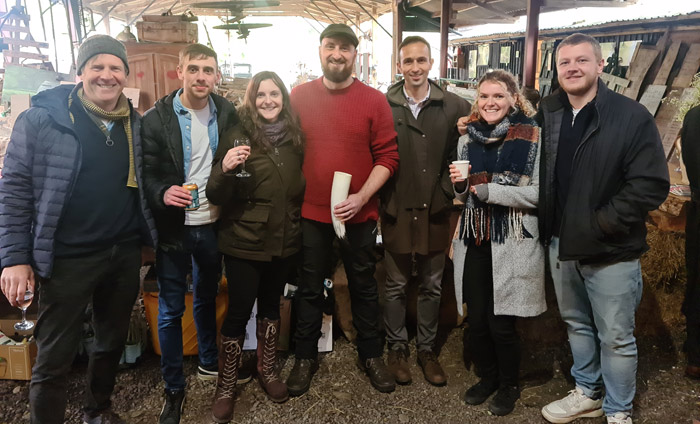
Following what has been a long winter characterised by COVID restrictions and endless video meetings, the Infotex team finally had a get together with a gathering in east Suffolk. In previous years the Infotex team normally try to host at least two company social events a year – the Christmas party and something outdoors in Summer. This event marked the first time we had been able to meet socially since the Christmas party in 2019. For many it was the first time they had actually seen each other this year, and for our new starters (Jono, Gareth and Mark) it was the first face to face interaction with the rest of the Infotex family.

It was also very exciting to see Jasmine, who is currently on maternity leave, to introduce us all to Riley, the latest member of her family.
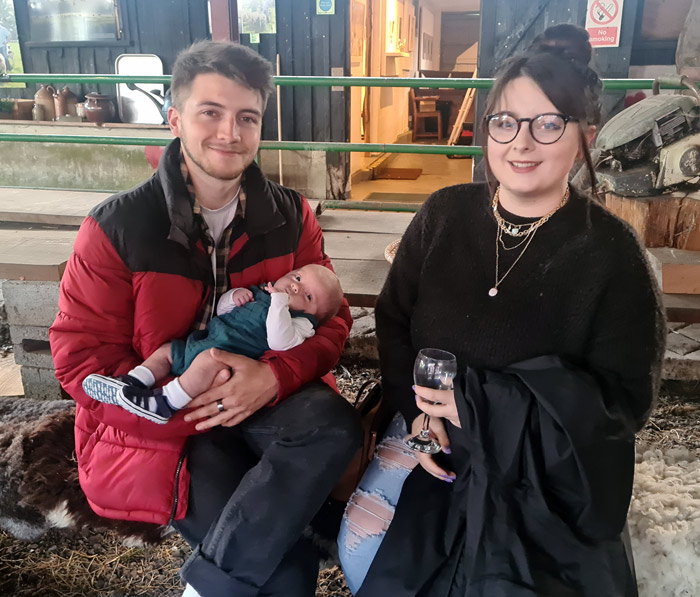
Alde Valley
The event was kindly hosted by our dear friend Jason Gathorne-Hardy. He generously welcomed us to use his wonderful farm in Great Glemham where the annual Alde Valley Spring Festival is held, with access to the various art studios, fed us with mutton, vegetables and salad from the farm
The evening was made up of walking in the wonderful countryside, looking at art, drinking, cooking mutton over a roaring fire and lots of conversation, capped off with toasted marshmallows and Jason’s delicious “chai”.
It was a time for us all to reflect on the previous years trials and tribulations, but also to celebrate that we got through it and look forward to as lockdowns ease further and the vaccination rate continues to rise.
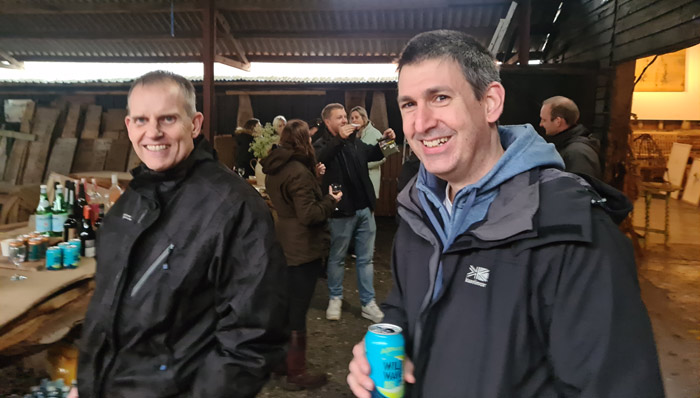
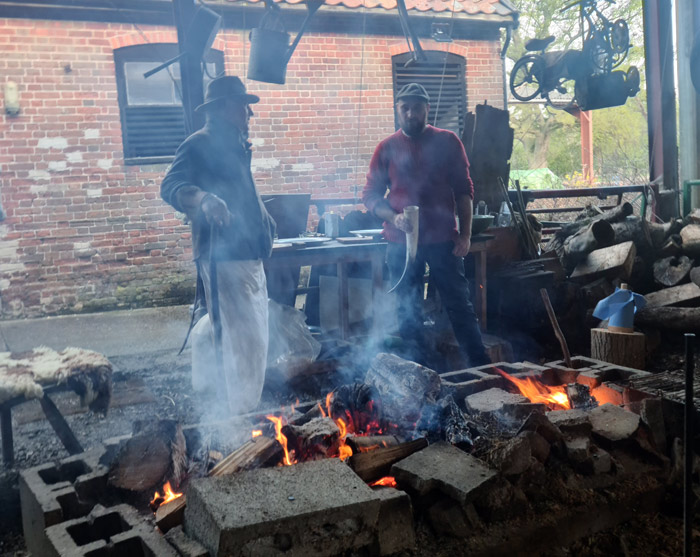
Check your router, it could be putting you at risk
A Which? survey suggests that up to 7.5 million Brits could be at security risk from routers that have default passwords, or lack current firmware and security updates. Please check yours. We know how poor and / or default passwords provide a huge risk to networks, emails and websites, so consider a tool such as LastPass which allows you to safely store all your passwords without having to remember them.
Suffolk in Trials for Emergency Alert Text
A new Emergency Alert system aims to more quickly and effectively get life-saving messages to people across the UK. East Suffolk has been chosen as the place to run out the first test alerts. Hopefully it won’t go the same way as Hawaii’s 2018 nuclear early warning system, where someone pressed the wrong button notifying islanders of an inbound ballistic missile, including the line “This is not a drill”…
Remove Backgrounds from Photos
www.remove.bg Simply drag and drop a photo and it’ll trim out the background automatically. While the free version limits you to small versions of the image, a pay as you go model can make it as cheap as £0.22 per image.
Online Photo Editor
Looking to do more with your images than just remove a background? pixlr.com is an incredibly powerful online image editor available for free.
With internet sales accounting for over a third of all retail sales in the UK, we thought we would dig deeper into the trends keeping ecommerce businesses ahead of the game. And first, it is video.
You may know already that the younger generation are the video generation… and they’re only going to continue growing. TikTok, Amazon Live, InstagramTV… it’s hard to ignore that video is the desired content. In fact, data from The State of Video Marketing Survey 2021 suggests that the average person watches 18hrs of video content every week (2.5hrs per day).
No wonder YouTube remains the second largest search engine in the world. Since its first video upload (“Me At The Zoo”) in 2006, it has grown and grown. Easy to upload to, and easy to embed into your site, it can also help you gain additional exposure in search engine result pages. And it’s free.
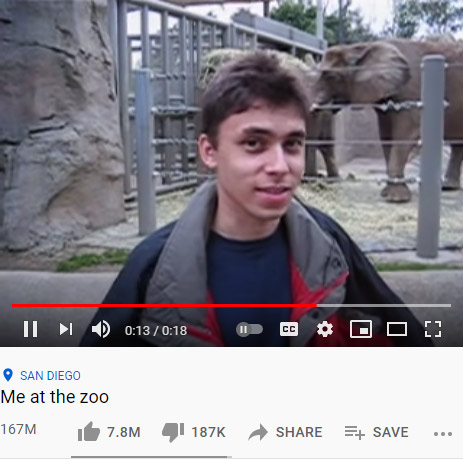
Video is the best virtual option for bringing people closer to a real-life retail experience. ASOS were one of the first to allow users to get a view of how their clothes look on a real person while they walk up and down – not exciting, but video that is certainly well appreciated by their customers.

Now some stores even have virtual fitting rooms – like Visualook – so that you can make sure you get the perfect size. In our current pandemic situation more than ever, people are looking to live out physical experiences recreated as closely as possible online.
You’ve probably heard by now that, as a result of technology, most people online have a shorter attention span than a goldfish (8 seconds compared to their superior 9). This means that there is a small window to catch someone’s attention on your website homepage or in their social media thread. Videos are proving the most effective way to do that.
In case we need confirmation of the attention-grabbing quality of video… it says it all that people are twice as likely to share video content with their contacts than other types of content such as text, images or audio. This has big benefits for social media expansion.
Video is rankable on search engines, and so it can help increase traffic to your website in the same way as text and keywords can. Videos will not only increase your organic traffic in this way, but are easily shared on social media, which in turn leads users to look up your product in search engines for more information.
Having videos on your ecommerce website builds trust between you and your customer. Clients can more clearly and accurately see the product depicted, and are therefore more likely to believe that they will get what they pay for. What’s more, the investment you make in the creation of the video informs your client of how strongly you believe in the value of your product.
When customers feel properly informed about a product, they are more likely to convert to sale. Similarly, knowing what to expect in a product means that customers are less likely to return an item if they’ve seen it on a video.
The most commonly-created type of video for ecommerce are explainer videos. Quite simply, they explain your product or service. Often animations, such videos provide the means to concisely and effectively communicate what your business proposition has to offer. Dropbox notoriously found its market through its explainer videos released by founder Drew Houston to communicate his concept.
One of our clients, Access Garden Products, uprooted some of their archive video guides from the 1990s and recreated them for their current products. Take a look on their website: www.garden-products.co.uk.

The closer a product looks online to how it really is when a customer receives it, the less likely it is to be returned. Product demos help a client to know what to expect from a product, and this increased trust means increased conversions.
Take away that element of dissatisfaction that flashes across a customer’s face when the parcel just isn’t quite what they expected… Are mugs usually so small?
By offering a step-by-step guide to how to use your product, your clients will know what to expect and thus feel more secure in their purchase decision making.
Everyone is drawn to narratives, so having a short story video on your site can be an effective way to get clients interested in your brand or product in a personal way.
Online shopping can be overwhelming, even just in terms of choosing from the sheer range of products on offer. A comparison video can help a client decipher between two similar products on the market, and clearly outline the pros and cons of each to take away some of that purchasing reluctance, and help them make an informed choice.
User-generated videos are on the rise, and, in the same way as written reviews, can do wonders in building a potential client’s trust in your product or service.
Earth Day, annually on 22 April, draws in over a billion people across the world to participate in activities to highlight the urgency of the climate crisis and the need for action. Due to the continuation of the pandemic, the event is taking place online again this year, with 10 million people expected to tune in – no simple feat, technologically speaking. But EarthDay.org are prepared, having had to build suitable online networks last year when the movement was forced online at the last minute.
More than just social-media outpours, EarthDay.org have proven the extraordinary reach of the media, and from the start of 2020 through Earth Day their outreach and messaging received over 9.9 billion impressions from readers, viewers, and listeners globally. The Earth Day movement lasts for 3 days – this week has already seen a global youth climate summit held on April 20th, led by Earth Uprising, and, yesterday, a multilingual summit on climate education, spanning several time zones and featuring activists from every continent. Notably, today’s event takes place in parallel to the Biden administration’s Leaders’ Summit on Climate. The Earth Day Live line-up includes 10 hours of digital programming, with talks and panel discussions, workshops, and special performances, focusing on Restore Our Earth™.
Even if you don’t have time to tune in, you might be interested in EarthDay.org’s clever Earth Challenge smartphone app. The app has some exciting features: individuals can take photos of the horizon nearby and upload them to help scientists track levels of air quality, for instance. The app also includes Artificial Intelligence integrations, so that, as more and more people add photos of types of plastic found in natural environments, AI will learn to recognise and classify specific types of plastic in the environment, eventually establishing details such as the manufacture source of a plastic drink bottle. As well as the “Collect and Classify” section of the app, you can “Take Action” in clean ups and community projects, and “Compete” to raise money.
Here are some other free apps we recommend for anyone wanting to live a more sustainable life:
Every business has a part to play in the movement toward a sustainable future. At Infotex, we are realising that we need to think deeply about how we can clean up our digital services – keep an eye out for more to come on this in the coming weeks and months. If you’re not going to tune in to Earth Day Live, or visit your nearest beach for a clean up, then why not have a think about your or your business’s environmental impact, too.
For more information visit earthday.org.
If Netflix has you hooked, then it won’t take you long to get your head around the concept of smart content loading. Have you noticed that today the ads on your computer screen are selling you exactly what you were searching for yesterday? We’re moving into a world where user data is personalising our online experience, and customers are happy to hand over their details for the right results. It’s no wonder 47% of consumers check Amazon if they’re unsatisfied with the products suggested by the brand they’re shopping with – the personalised shopping experience is too good to resist. Well, now there are increasing opportunities for smaller businesses to tap in on this consumer impulse.
Smart Content refers to the dynamic elements of your website that change depending on the site user profile. Instead of being restricted to typical static content, which stays the same for everyone, smart content offers some important benefits: it targets individual customers with a personalised experience, and also increases site loading times. These things combined mean that a website with smart content loading built in will drive significantly higher conversion rates and ROI than one without.
In order to determine which tailored content to show when a unique user visits the site, smart content responds to demographic/firmographic user data (age, gender/business details) as well as behavioural (on-site activities and history) and contextual data (location, device type, time of day). This way, websites can optimise their content to increase engagement through offering visitors only the most relevant material. For example, your smart content system could tweak a landing page instantly when it knows a certain user has visited the page before, offering them a new and more relevant response the second time around. By finding out who your customers are, you can offer a friendly, personal service that keeps them coming back again and again.
Site loading speed is always a priority for engaging users. But businesses are also increasingly opting for smart content loading with the same aims of maximising page visits, time on site, and reducing bounce rates. As a development of “lazy loading”, whereby site images are only loaded when necessary, smart content loading websites limit downloads to the necessary content for a particular user, saving time by withholding unnecessary text and images.
If your potential leads have varying needs, interests, desires, or character profiles, then you should employ using smart content loading.
Some examples of the types of smart content you might create include targeted blog posts and articles, personalised calls-to-action and case studies, discounts and offers, and video content. You don’t need to go full steam ahead to begin with, but gradually segmenting the traffic to your site will enable you to make the most of your business online and keep those potential leads returning.
However, the aim is to offer a personalised, suitable experience without appearing overly familiar… no customer wants to feel like they’re being watched without remembering giving permission, so there are some things to avoid, too. For instance, unless it is a situation where the user will definitely remember their prior visit to the site, smart content loading should avoid using a user’s personal details such as their name and location.
Technology is creating amazing opportunities for small businesses online, including smart content loading. If you feel like your business is too small, or too far behind the current internet trends, you’re wrong! There’s never been a better time to join in with the excitement of web development and help your business outcompete the rest.
Get in touch for website advice, or read about more top website trends for 2021 in our blog.
With 2.14 billion people worldwide predicted to buy goods and services online in 2021, it’s no wonder everyone’s talking about the future of ecommerce. We’re dealing with an ‘ecommerce supercycle’, as termed by the major ecommerce platform Shopify, after seeing 10 years of ecommerce growth happen in just 90 days in 2020.
In the UK, internet sales account for over a third of all retail sales in the UK. Rapid growth, however, is decreasing, and will likely decrease further into 2021 (as global recession is set to reduce total retail spending). Yet it is still important to look at this boom to see what we can expect from consumer habits in the years to follow. M&S’s new mantra from last May, “Never the Same Again”, may have seemed a bit drastic, but it marked what we now know was a necessary transition of the company toward online business, and is one that we might all need to keep in mind in order to make it into the future market.
So, let’s take a look at online spending trends, and, most importantly, what you can do about them to help your business.
The implementation of personal information analysis is set to become a regular eCommerce trait. With the help of artificial intelligence and machine learning, ecommerce relies more and more on collecting user-journey data, including demographics, browsing habits, and buying history. This means that, using consumer data, machines can personalise the shopping experience to each user, uniquely.
For an example of how you can personalise your website, read more about Smart Content Loading in our blog.
It only takes a pandemic to drive people to order online, and, once in the habit, you know how easy it is. This goes for all platforms, including social media. Before, social media ads tended to target the 25-54 age range group, but as our parents start to communicate on Instagram and the like (welcome, Boomers), online media advertising is becoming broader, and evermore targeted.
In fact, we are seeing rising numbers of both younger (16-24) and older (55-77) consumers purchasing online. The younger generation of e-shoppers have been shown to purchase high proportions of clothing, shoes and accessories, food deliveries, digital goods and accessories, cosmetics, and sports goods, while the older group tend to buy higher proportions of furniture, home and garden products, medical or dietary supplements, and books, as well as clothes and beauty.
Online, more and more channels are adapting to the rise in ecommerce. Social media platforms are the most significant, transforming from advertising platforms to having their own selling features, such as Instagram’s “shoppable post” feature.
All this talk of ecommerce is by no means to suggest you have to get rid of your brick-and-mortar store, though. Moreover, businesses are becoming experts at combining physical and online services to provide the best customer-service experience. This might be by introducing an ‘order online and pick-up in store’ feature, or by opening pop-up shops in different locations.
The growth of ecommerce means that people now have the space to choose which brands they buy from, no longer being limited to the stores physically nearby them. With environmental concerns ramping up, sustainability and ethical consumption is becoming a game-changer in retail markets, as it is often a top priority for consumers.
Most of all, don’t lose hope. The rapid growth and change in ecommerce might seem daunting, but this is the best time for your business, big or small, to jump on the ride. Take the long view and tap in on the remarkable demand we are seeing for services online.
If you are looking for ecommerce expertise, get in touch.
When Nicolas Kurona stumbled across Google Argentina’s domain available for purchase, he legally purchased it, as you do.
‘Dumbfounded, he tapped www.google.com.ar into his search bar and pressed enter.
“My personal data appeared,” he said. “I was frozen looking at the screen. I could not believe what had just happened.”‘
Goodbye to Yahoo Answers
Yahoo Answers is closing down forever on May 4th, and it’s being likened to the burning down of the library of Alexandria. The Guardian are just one example of people gathering what they think are some of the best questions before they’re lost forever. Do you think humans will ever walk on the Sun?
Facebook v Apple: personal data stands between the giants
Apple iPhones and iPads will be updated this week to include a feature that gives users autonomy over whether their data can be collected by apps. Facebook, who rely on data for advertising success, are not happy.
Google Earth has introduced a timelapse of the Earth, by combining 15million satellite images from over the last 34 years.
Founded in 2011 by Irish brothers John and Patrick Collison, Stripe helps businesses around the world process online payments. Its whopping $95 billion valuation made the news this month, landing it way ahead of even Elon Musk’s SpaceX . Stripe might have slipped your radar as it offers services to businesses, not consumers, but as a payment gateway mastermind its success reminds us that ecommerce has no intention of slowing down…
We are arriving into a new age where the quantum internet can ensure secure data transmission, suggest recent experiments. Quantum communication relies on the laws of quantum physics, making it not just difficult, but impossible, to intercept.
Remember when Apple delayed the release of the iPhone 12 due to a shortage in computer chips last year? Well, it appears this crisis is coming to its head. And that’s before OVH ordered 30,000 new CPUs for the rebuild of the data centre which burnt down the other week! Expect prices – cars, computers, phones, games – to rise, with industries struggling to get factories up and running after pandemic closures.
NFT technology saw Twitter’s first ever tweet by its founder Jack Dorsey – “just setting up my twttr”- selling for $2.9m online. The Non-Fungible Tokens are used for unique trades, be it for online art, music, domain names, or anything else digitalised. Unlike fungible currencies like Bitcoin, each NFT is one-of-a-kind digital asset. Perhaps you want to take your Pokemon trading online?
Speaking of hacking, this month a Casino was hacked through a smart fish-tank thermometer. So what can we take from this? (Not fish)… Check the security on your Internet of Things devices – that’s your Alexa, smart hoover, security camera, you name it. They’re not always as smart as you might think.
Following on from last month’s Snap Camera add-on to make video calls more exciting, for those less technically minded why not just hire a goat for 5 minutes to join your Zoom call? Cronkshaw Fold Farm lets you hire them for 5 mins. Not a fan of goats? Hilly Ridge Alpacas in Wattisham let you have an alpaca join.

As any regular readers will be aware, the GDPR is an act of the European Parliament which came into force in May 2018. It is designed to give individuals (formally called data subjects) far-reaching control over their personal data with severe penalties for any bodies (formally called data controllers) who cause a data breach that fails to protect that data or act in accordance with the existing agreement with the individual.
Two of the key tenets of the act are the right of access and the right of erasure:
A Data Subject Access Request could be summarised as allowing the individual to ask a data controller what personal information it, and it’s sub-processors, holds about them and to request a copy of this data in addition to being transparent about how this data is processed on their behalf. Typically this takes the form of an email or online form that the individual will complete with their name and minimally identifying information which is sent to the controller who responds with the full data set in the most human-readable form possible within 30 days.
The Right to Erasure, also known as the right to be forgotten, is similarly summarised as allowing individuals to make a request instructing that the information previously provided be deleted in whole or in part, which the controller must comply with by erasing or pseudo-anonymising this data in such a way that it can no longer be linked to the individual.
GDPR is certainly well-meaning and as is so often the case the issue arises in the implementation of these powers by Data Controllers.
In short, attackers have discovered that many companies, in their role as Data Controller, do not validate who made the request before providing or erasing the data.
Let’s take a simple example, our attacker is looking for information to conduct an identity fraud against Mr Bloggs, they contact Company A who receives an email looking like the below:
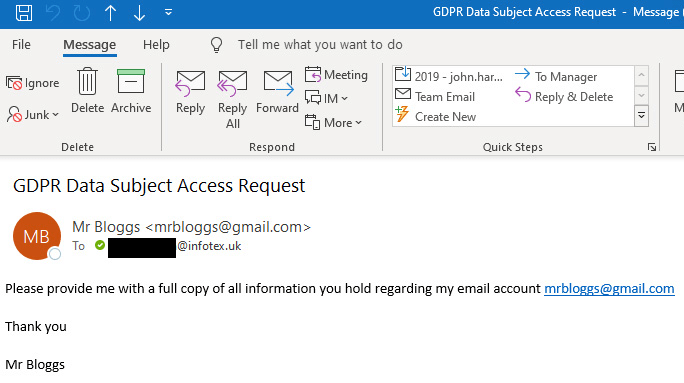
Stop for a moment and imagine you received this request with your email address in the To: field. Would you process the request and reply to Mr Bloggs with the requested information?
Are you quite sure??
Look carefully at the below screenshot of where your reply would actually be sent to:
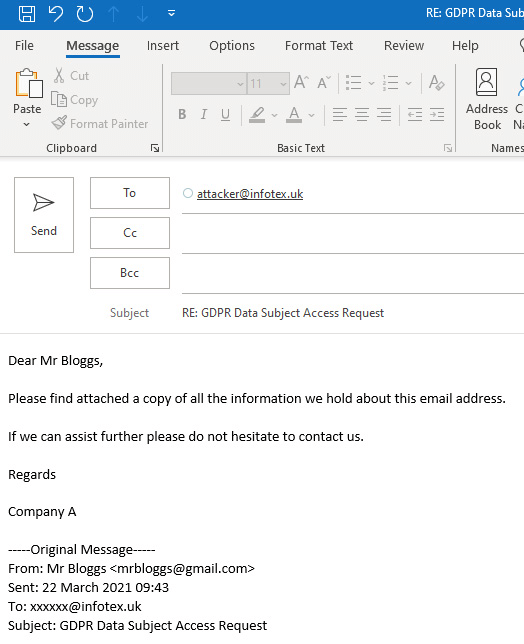
The trick here is that the attacker utilised a long-established email header called Reply-to causing the original email to appear to be faked to originate from mrbloggs@gmail.com while the response would be sent back to an entirely different address, attacker@infotex.uk in this example.
If the above response was sent with an attachment containing all the personal information held about Mr Bloggs, then that personal data would now be in the hands of the attacker helping them to conduct whatever identity fraud they had in mind.
By the simple act of sharing this information without Mr Bloggs explicit consent Company A have just unwittingly caused a data breach, for which they could be prosecuted under the very GDPR that they thought they were complying with.
In the case of Right of Erasure requests, in many cases companies who receive such requests simply permanently delete, or anonymise, the customers data and reply confirming that this has been erased. This can be even worse as there is no need to send a reply-to header, simply fake the email address which the request came from and you have just deleted Mr Bloggs data, the first he knows is when he next contacts Company A and finds that they no longer know anything about him, potentially losing any files, order history, product warranties etc held by them on his behalf.
In this instance if requests are blindly processed then even without a reply-to header the data has been destroyed before the actual individual knows anything about it, perhaps the attacker may add a CC so that the company can let them know that the data has been deleted as well!
The first thing is to ensure that you scrutinise any requests received, in particular ensuring that the email address you are replying to is the account you hold on record.
As the act allows up to 30 days to comply with such a request you may also wish to send an email or call Mr Bloggs (ensuring not to reply-to the original email) to confirm & validate the request, this may also give customer service benefits allowing any grievance that has led to a legitimate request to be dealt with more amicably while also allowing a legitimate customer to respond and query the request.
If you have automated systems to process requests, test how they handle reply-to and CC email headers to ensure that they are not allowing data to be handled in unintended ways.
Credit to Hx01 (https://twitter.com/hxzeroone) whose paper inspired this post.
Cliftons are suppliers of Lawn Mowers, Strimmers, Hedge Trimmers, Chain Saws, Ride on Lawn Tractors, Garden Shredders and more.
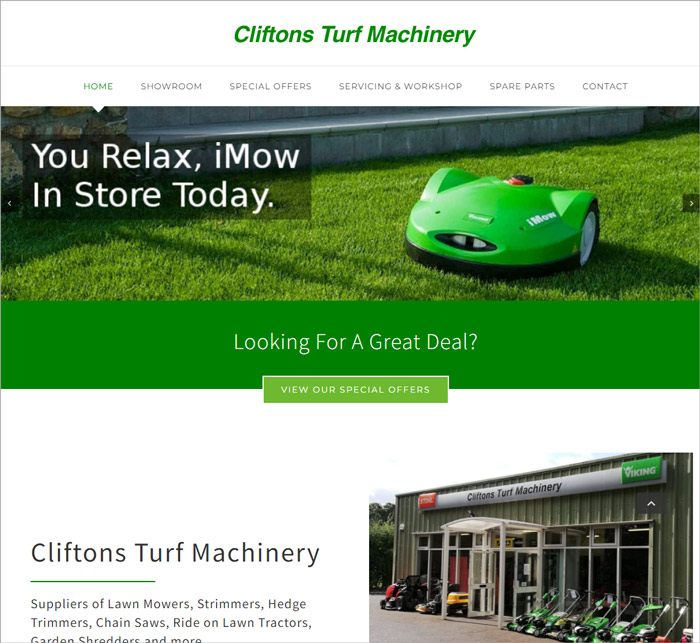
Their new website was designed to show you the broad range of brands and types of machinery that Cliftons sell, and the services they offer. They provide servicing and repairs for garden mowers and machinery, as well as having a well stocked spare parts store. Established in 1965 by founder Richard Clifton, their aim is to continue their tradition of high quality service, and drive the business forward into the future.
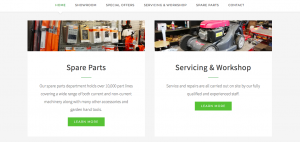
If your current supplier just doesn’t cut it, then you know where to look.
Video killed the radio star? Maybe, but Radio.Garden is an app and website that lets you choose and listen to radio stations from around the globe. It aims to blur borders and connect people and places through the joys of radio.
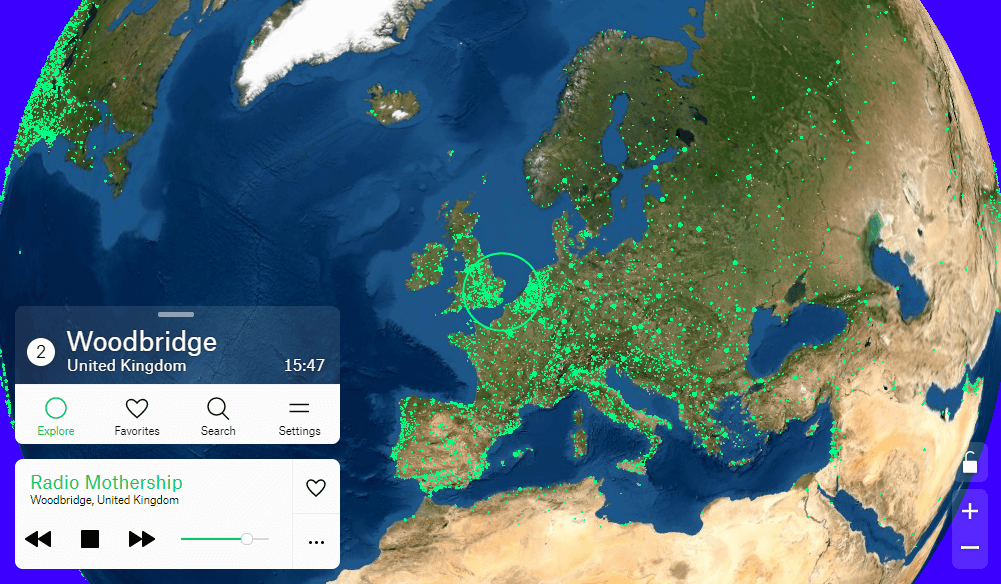
You probably heard about the Texas Lawyer who went viral after getting stuck with a cat filter during a virtual court case. An easy mistake to make…? Well, the technology that made it happen is nothing sophisticated – it’s decades old.
If you want to light up your meetings with the occasional filter, you can download the Snapchat app, Snap Camera, and integrate its filters with Zoom.
One of our Account Managers, Kris, is particularly good at putting a smile on everyone’s face in our remote company meetings, by turning up with a clever filter or other greenscreen shenanigans. Here he is as our Office Party Quizmaster in December, and a behind the scenes shot of the elaborate setup.
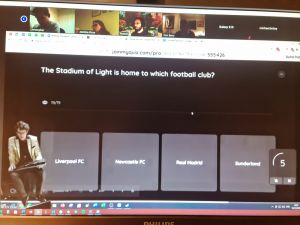
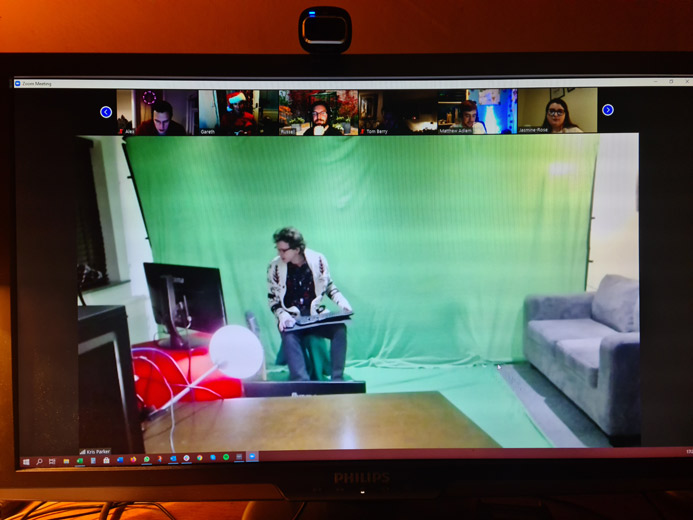
A death in a film can be very upsetting, I’m still not really over The Lion King to be honest. DoesTheDogDie.com prepares you for anything that may surprise you – not just animal death – so obviously it’s a bit of a spoiler-fest but sometimes it’s good to know beforehand.
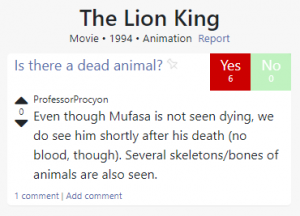
I’m at my desk, in “the TV room” at home, which I have claimed in a military manoeuvre. It has undergone an upgrade over the weekend from “where I work when at home” to “the office”.
I click the “Google Hangout” popup alert and in a few seconds I am presented with a striking array of familiar faces. We have 22 people working in Infotex. Not all are full time, but today everyone is on the call. I can see a wall of anxiety on my desktop and I am not sure what to say to it. So at first I waffle on about how this is all unprecedented and we must brace ourselves for a commercial shock. But unlike many managers out there, I am able to turn to something more concretely positive: the silver linings at our disposal as an online business able to continue to operate more or less unaffected. How there is an opportunity for us to show leadership and courage, and to advance our online services in new ways, as the internet is now about to come to the fore.

We start to have a general chat. James picks up the theme and adds that it’s as if we just pressed fast forward on the things we have all believed in for years – the remarkable ability of the Internet empowering individuals and organisations to communicate and collaborate in ways that are so much more effective than ever seen before. We observe that the very meeting we are all having now is, well, comfortable and extraordinary in its quality. A reassuring facility in uncertain times.
This concept hits me with a force – that in a world which has suddenly become utterly unpredictable, we need to create some new certainties. The handrails and toe holds of life are about routine and certainty. I tell the team boldly “right we will meet here online every day at 9am for 15 mins for a catchup and general chat about things, then let’s take things one day at a time”. I do this as I sense everyone, me included, is going to need a new structure.
After three days of 9am catch ups, I start to meet resistance. Everyone is facing multiple challenges at the start of each day, with numerous Hangouts, Zooms and Meets, plus lots of production operations to get through. “Let’s try meeting at lunch time from tomorrow onwards”, I suggest on the day 3 catch up. There is then a typical Infotex discussion – friendly but firm, with plenty of opinion and sense of humour – about when lunchtime is. ‘Turns out some go for lunch as early as 12, and some as late as 2. This is not as disorganised as it sounds, it’s all about making sure we have people available all of the time for our clients when they need us. “Right”, I say, determined not to be outmanoeuvred, “we’ll have our catch ups at 11-45 daily – no one can say it’s too early, and no one can say they’re off for lunch”. And so it begins.
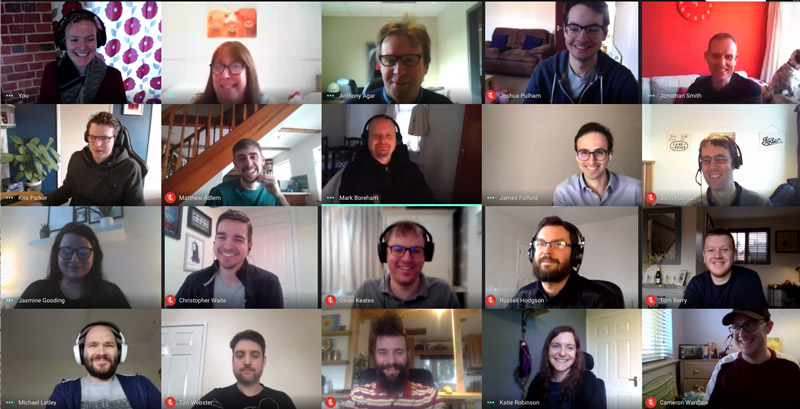
Lockdown continues and like thousands of small businesses all over the country we are now experts at working from home. We have had the Company Catchup at 11:45 every working day since March 23rd. The team has worked hard throughout to support our many clients with updates to their websites, as they all adapt to their changed worlds. Some clients have been exceptionally busy, with online sales many times greater than ever seen before. This produces challenges all round – one client, for example, quickly ran out of the small bags they use to sell to consumers, as their flour business was mostly selling to trade in large bags. Another client had to adapt their shops to become pick-and-pack centres and had streams of demand from customers wanting deep freezes and more audio visual equipment. Many of our clients had to shut down and just needed us to update all their messaging to tell customers about their new arrangements.
Like our clients, we are emerging from the mist and thinking about future plans and what will be the new normal. Already we know that we are never going back to the way we were before March. So how do we want to organise ourselves in the future, in a post-Covid world? We decide it’s time we did a survey, so Katie polls the team. She asks them to talk from a personal perspective (what they want for themselves) and from the company’s (what they think is best for the company’s future). The results, perhaps unsurprisingly, reveal how none of us can yet see very clearly into the future… but they do also show a distinct preference for working from home.
Meanwhile we make the office “Covid Secure”, although it remains mostly empty, and we offer our unused space to three small businesses that are struggling their way through the pandemic and are in need of working homes. My grown-up children offer to re-paint it so that it will feel fresh on our return in the Autumn.
When term starts, we reopen the office for a handful of those who want to go in part time, which feels like a reassuring step in the right direction.
With no sign yet of Lockdown 2, we decide to do a proper plan for 2021, which calls for a repeat of our June survey. Same questions, different answers this time. It seems about half the team believe they will work best if they can come and go to the office flexibly when restrictions are lifted. The other half want to keep working at home. There is much less indecision.
| Return to work in office? | Jun | Nov |
| Part time | 1 | 11 |
| Full time | 2 | 0 |
| Undecided | 8 | 2 |
| Never | 12 | 10 |
The Company Catchup has sustained throughout the summer. Even as lockdown eased, with calls to “Eat out to Help Out” and “Get Back to Work”, bolstered by our June survey results, we decided to hang on to our newly formed habit, reluctant to let go of all the benefits we are feeling. The Catch Up has found its own rhyme and reason:
Mondays – we pick up from the weekend. Then our production manager Katie runs us through all of the projects going on across the business, and highlights key events – launches, workshops, client meetings, internal sprint reviews.
Tuesdays – The week is underway and scheduling has been finalised the day before, so Cameron our Support Manager highlights how things are on the front line of support – any major maintenance upgrades, clients facing operational challenges and needing priority support.
Wednesdays – There will have been digital marketing and development meetings in the morning, so things can turn a bit geeky. We hear from Tim our Digital Strategist about cool stuff he is doing with clients to help them improve website performance. And Chris, John, Richard and the developers all chip in with updates on technical stuff they are up to.
Thursday is People Day – we raise admin matters – holiday plans, documentation, etc. And this is when we might have a guest speaker – our shareholders or creative partners for example.
Friday is think about the weekend. I tend to turn to our designers (the art department) to bring some colour and light to the conversation, and remind us of the importance of nurturing the artistic soul in our world of design and technology. We are blessed to have Jonny as our head of design, supported by Alice, they are a winning combination team.
By now we have also been successful in winning new business – engaging with, and selling to our clients online, and now working with them creatively. Out went the old one or two day workshops, involving car and train journeys and fabulously complicated logistics to get the necessary people together for quality time. In replacement we are seeing 2-day workshops achieved in several 2 or 3 hour remote sessions , with all the people we need to be there – Infotex and Clients – always able to attend, and with the luxury for our designers to be able to sit in on tech meetings, and our developers to sit in on design meetings, which so often in the past had been difficult to resource.
So, slowly, we feel, we are finding our sustainable path through this new world.
Lockdown 2 (or is it 3, or 4?) is now well underway. This time round, the whole nation, and nations abroad, seems more subdued. Our intention, stated in September, to re-open the office in January, was abandoned before Christmas, by then we knew it wasn’t going to happen. The Company Catch Ups have become about more than just routine and certainty, they’re about keeping well-being and companionship up too, in a world where human connection is at risk of slipping.
There are no rules. I have heard of all sorts of ways that businesses are helping employees navigate this new landscape. Each company and organisation needs to find what works best for it. As always with the adoption of new technology, it’s important not to let your natural tendency to want things to stay the same hamper your ability to adapt and grasp the positives.
For us, we will re-open our offices at the end of June and everyone will have a place to come to work. But as a company we have seen the benefits of working remotely and we intend to build on these learnings. For example, meetings will continue to be video based by default, so that they are always attended by the right people and the logistics can be frictionless.
The UK now has a road map and we can, at last, plan against a framework that will see an end to the lockdown and the most severe restrictions. All the indications are that there will be no “after Covid”; we are now in a “living with Covid” world. But regardless, and whatever restrictions remain on movement and social contact, we have all been propelled, as James said in our first lockdown meeting, into using the Internet with more imagination than we thought we had, for the improvement of how we run our lives.
Discover how our team can help you on your journey.
Talk to us today